Low Frequency Astrophysics & Cosmology
One of the three research objectives for the LUNAR team is to study the early Universe. There is an observational gap in our understanding of the Universe's history, during the cosmological "Dark Ages". The signals from this epoch are sufficiently faint that they may be detectible only from the radio-quiet lunar farside. The LUNAR team is developing the scientific motivation and technologies to be able to conduct these observations.
Scientific Motivation
Only 400,000 years after the Big Bang, the baryonic matter in the universe (still only ~4% of the total mass) was composed almost exclusivly of hydrogen. The neutral hydrogen molecules had an almost perfectly uniform distribution across the Universe. Small overdensities in the gas were the 'seeds' for later gravitational collapse of stars and galaxies. One billion years later, the Universe was rich with structure, and the primordial gas had been enriched by heavy elements created by stars and supernovae. Almost all of this gas had been ionized (had its electrons stripped away) by the first stars and galaxies, and heated by radiation from X-ray sources such as the accretion discs of black holes.
The earlier of these two epochs, called Recombination, has been studied using the cosmic microwave background, as revealed by experiments such as COBE, WMAP and Planck. The later epoch is coming within observational range of our largest ground-based telescopes, as well as the Hubble Space Telescope. However, the billion year period between them remains far more mysterious.
Astronomers typically divide this billion year period into three eras: the 'Cosmic Dark Ages' before the first light sources in the Universe had formed, the 'Cosmic Dawn' during the formation of the first stars and galaxies, and the 'Epoch of Reionization' during which time ultraviolet light destroyed almost all the neutral gas.
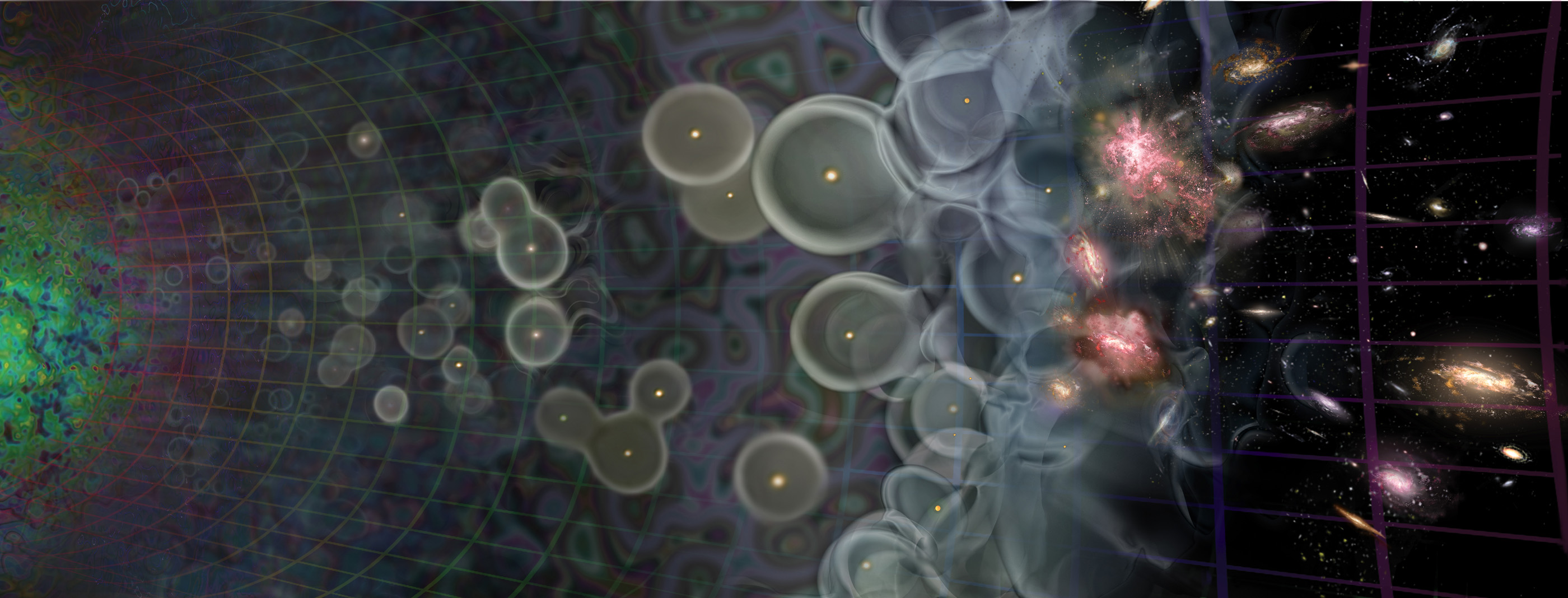
Figure 1: Artists conception of the evolution of the structure of the universe, starting with the epoch of recombination and ending with the formation of the first stars and galaxies.
The best hope for observing this period is the 21-cm radiation signal from hydrogen. Neutral hydrogen has two electrical states, and radiation is emitted when the atom transitions from the higher state into the lower state. In a terrestrial laboratory, this radiation has a wavelength of 21 cm, or a frequency of 1420 MHz. However, the 21 cm radiation from the early Universe is highly redshifted, so that by the time it reaches Earth it is at low radio frequencies, less than around 200 MHz. Research within the Low Frequency Astrophysics and Cosmology project of LUNAR is concerned with using the Moon as a platform to study this period. The team is developing tools and instrumentation to observe this radiation and subtract foreground noise. Teammembers are also conducting theoretical studies of the early Universe, to model the signal.
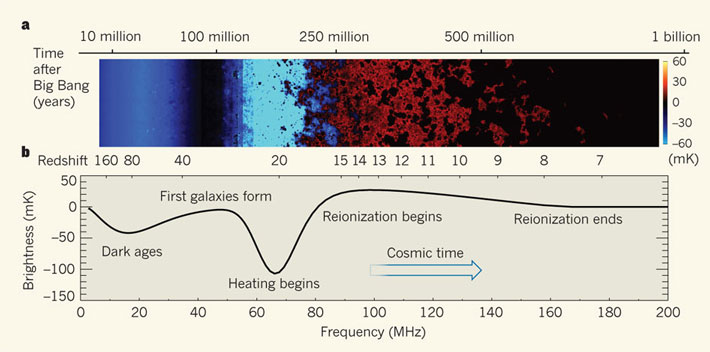
Figure 2: A schematic view of the early Universe in the context of studying it using the 21-cm line of neutral hydrogen. The Universe evolves in time from left to right. The top panel shows the structures visible in neutral hydrogen, blue being cold gas, red being hot gas, with black regions either being ionized (no neutral hydrogen) or at the same temperature as the cosmic microwave background. The bottom panel shows how the mean temperature of the hydrogen changes with time. Major epochs are also marked.
Since the signal the LUNAR team hopes to observe was emitted billions of years ago, it is very faint when viewed from Earth. Terrestrial radio sources, such as FM radio stations, military and commercial satellites, and many others, all interfere with astronomical signals,effectively drowning out the cosmological radiation the team aims to observe. Therefore, the radio sensing equipment must sit on or orbit around the lunar farside, which has been proven to be the only radio-quiet location in the nearby solar system. Designing a lunar telescope has been a dream of many scientists for decades, and the LUNAR team is working on a design that is durable in the lunar environment and cost effective to deploy and operate.
Theoretical tools
The team is simulating the early Universe using state-of-the-art modeling tools, such as the cosmological hydrodynamic simulation code Enzo (see Figure 3). This helps us to understand physical processes in the early Universe, and to generate predictions for what a low-frequency radio observatory on the Moon will see. In order to study the effects of X-ray heating on the 21-cm signal, past authors have often formed all AGN in the simulation volume in a “burst” at a single redshift. Recently, new simulations have integrated the capabilities of an inline friends-of-friends dark matter halo finder with new radiative transfer modules in Enzo. These simulations can generate a population of AGN that evolve naturally in tandem with the dark matter density field. X-ray emission from these AGN is propagated using an adaptive ray-tracing algorithm and is coupled to the hydrodynamics and chemistry solvers within Enzo, allowing LUNAR to study the resultant heating and ionization (and thus 21-cm signal) in detail.
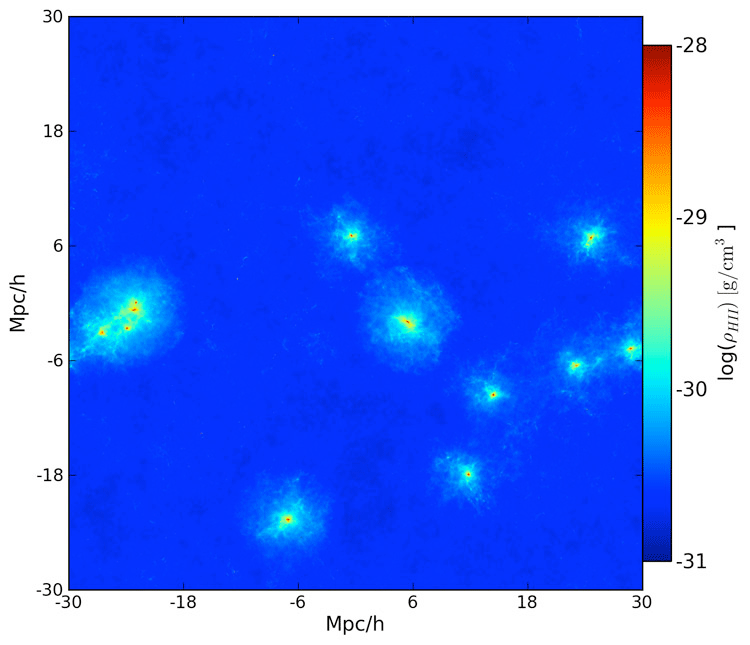
Figure 3: This is a snapshot of the Enzo code showing the radiative transfer of X-ray emission in the early Universe. UV and X-ray light were responsible for the heating of the Early Universe. UV photons are likely the cause of localized heating, but the X-ray photons have a larger mean free path and thus have the ability to heat at greater distances than UV photons.
Much research has been conducted to model what the predicted 21 cm signal will look like when a radio instrument is sent into space. The imaging regime is sometimes neglected for first-generation epoch of reionization arrays, since the low signal-to-noise ratio implies that only a very low resolution can be achieved. The 21-cm signal contains structures on extremely large scales, however, and so even low resolution images will provide valuable information about the structure of matter early in the Universe.
LUNAR teammembers have been working on foreground subtraction for the Low Frequency Array (LOFAR) epoch of reionization experiment, studying its impact on power spectrum measurements and imaging. Research done for the LOFAR array translates easily to applications for a lunar radio telescope. The treatment of the instrument response to incoming radiation incorporates the effects of a frequency-dependent primary beam and UV coverage. The large-scale signal simulations developed by Mesinger & Furlanetto have replaced the earlier simulations with a limited dynamic range.
Teammembers have also been studying inhomogeneities in the ultraviolet radiation background during the era of the galaxy formation. This background is crucial for “turning on” the spin-flip signal that a low-frequency lunar telescope would search for. It is also crucial for modulating the transition from exotic (and very massive) Population III stars to their more normal descendants. LUNAR has created a new model to describe fluctuations in this background analytically. It has shown that, in the simplest scenarios, the backgrounds are uniform at the 10% level.
This has two important implications for low-frequency telescopes. First, it means that a measurement of the mean intensity can determine the transition time between these two stellar populations. It also means that these exotic stars are likely to exist only in the earliest phases of cosmic history, so telescopes like a lunar array are essential to understanding their properties.
Technology Development
LUNAR is developing the concept of a Lunar Radio Array, which would consist of a large number of low-frequency radio antennas on the far side of the Moon. The signals from the antennas in this array will be combined to form a huge low-frequency radio telescope. The ionosphere and noise from man-made radio signals makes accurate low-frequency radio observations from the Earth's surface extremely difficult. A lunar array will be shielded from these noise sources.
The Lunar Radio Array will require a large number of science antennas, so a high sensitivity per unit mass is a key requirement. This will save on the construction and deployment costs, since sending a kilogram of material to the Moon is exceedingly expensive. Several antenna concepts are being explored by the LUNAR team.
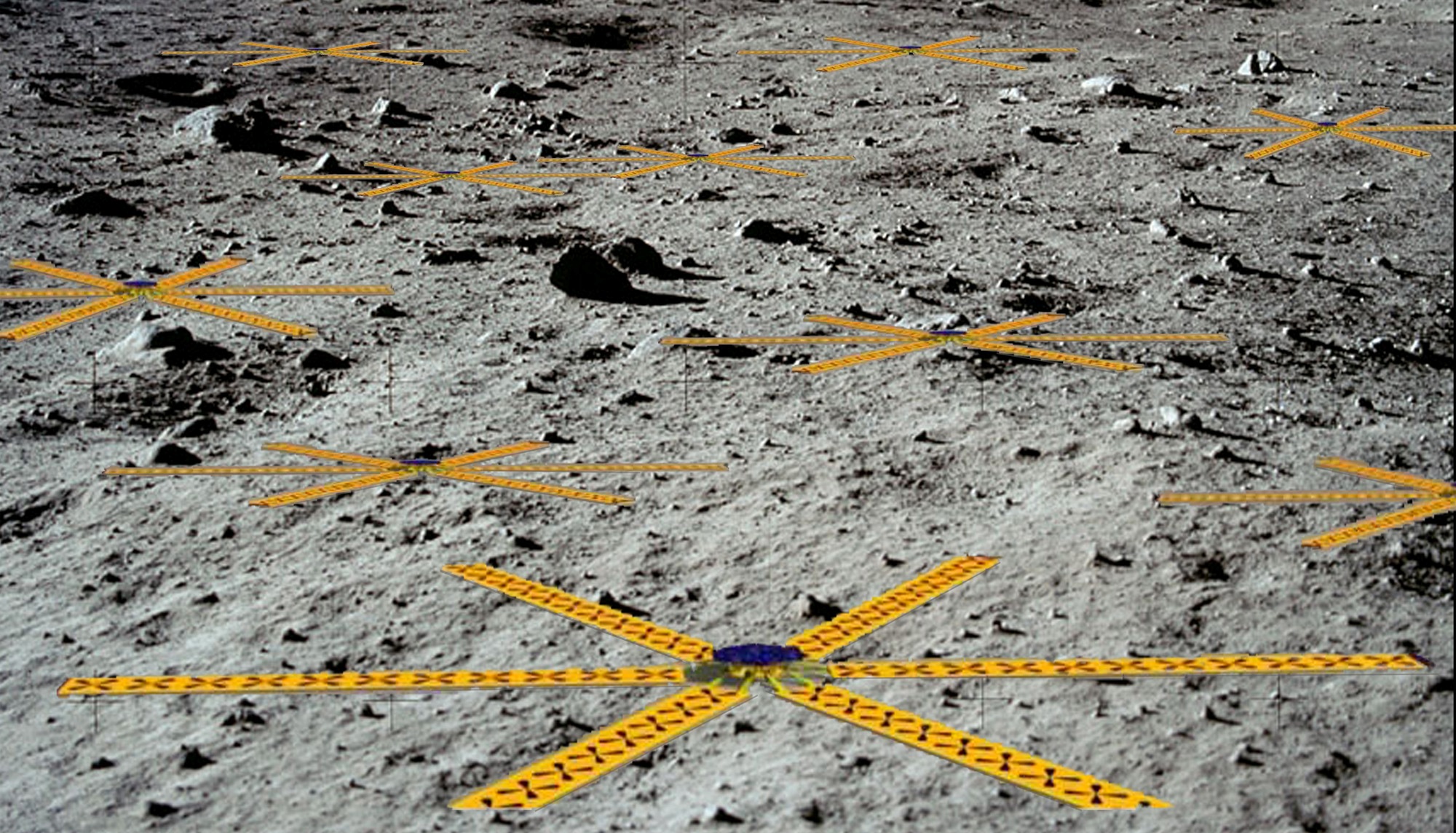
Figure 4: This shows a particular antenna design LUNAR is investigating. The black X's on the arms of the antennae are the photon-collecting dipoles. The yellow arm is made of a extremely thin sheet of Kapton film. The dipoles are connected by an electric transmission line to the central hub, shown in purple. This hub transmits the data back to Earth.
Figure 5 shows the vacuum chamber in which team members are testing a polyimide film antenna. Dipoles are printed onto a plastic film, which can then be rolled out onto the lunar surface by astronauts or a remotely operated rover. Several experiments to date have confirmed that Kapton, a thermally insulating polyimide film, is the best material to use for the antennae arms. It is durable under the extreme temperature varuations, low atmospheric pressure, and extreme ratiation environment at the lunar surface. The team is considering possible upgrades to the chamber to include lunar simulant and an electron beam to more fully replicate the lunar surface conditions. You can view the descriptions and results of these experiments HERE.
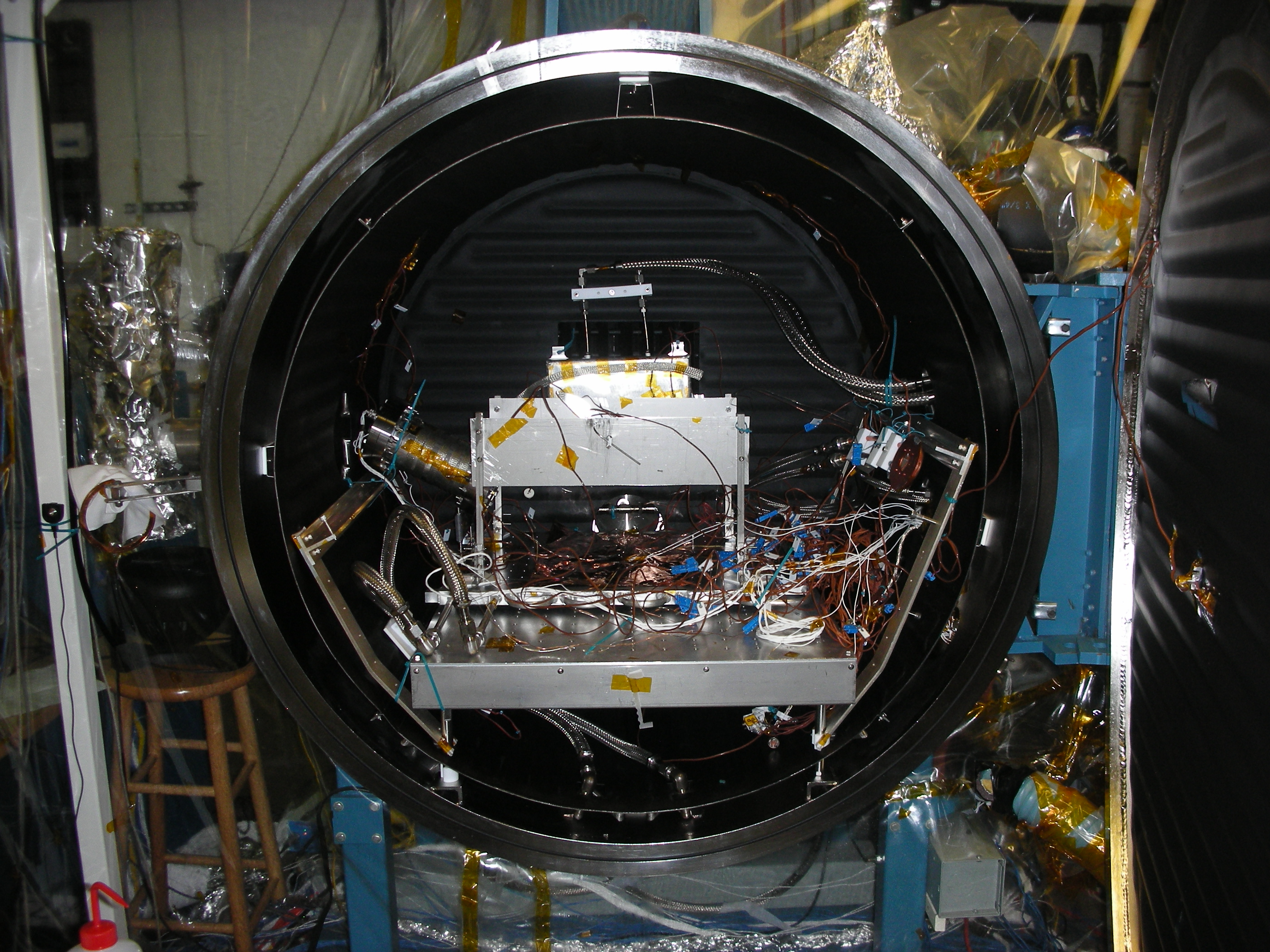
Figure 5: The vacuum chamber (LUNAR Simulation Laboratory) used to test how well a polyimide film antenna can stand up to the rigors of the lunar environment. The film can be exposed to high vacuum (10-7 Torr), cycled down to a temperature of -150°C or up to 100°C, and exposed to ultraviolet light.
The team has also conducted several 'backyard' tests of deployment techniques. These tests are useful to test the deployment of large sections of film and deployment systems with many moving pieces. The team is working on developing space-quality systems to more accurately test these deployment scenarios. Figure 6 shows the Kapton film in one such test.
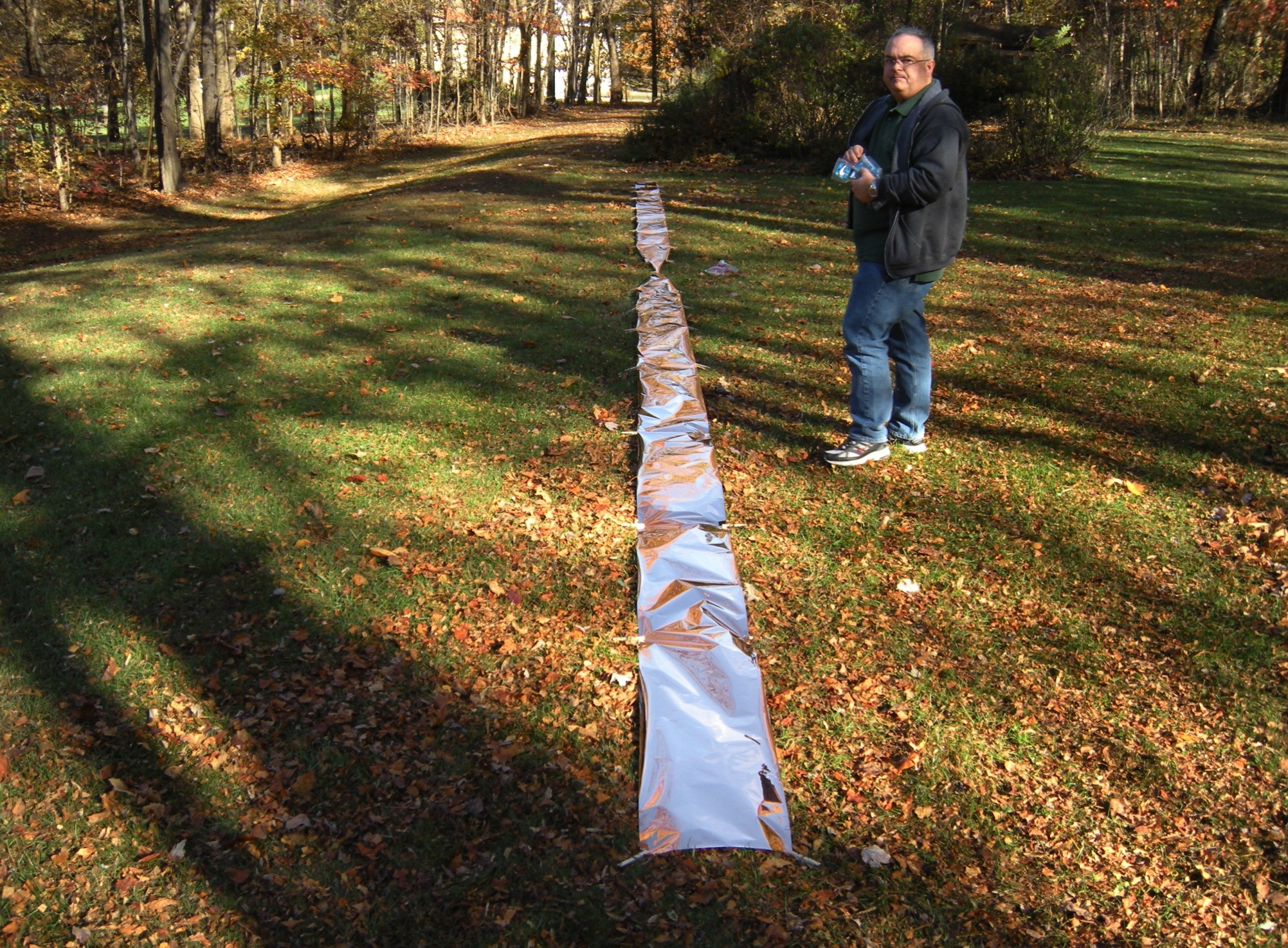
Figure 6: A backyard test unrolling of the Kapton film. This strip of film is much longer than what can be acomodated in the LSL vacuum chamber.
Array Concepts and Algorithm Development
The Lunar Radio Array must be designed so that it can achieve its science goals, and is robust enough to survive the extreme lunar surface environment. LUNAR is studying how to optimize the layout of the antennas in a future lunar radio telescope. The image below shows the layout that maximizes scientific return with the least amount of mass. Each dot represents a single antennae, which is a Y shaped structure with three flexible arms each containing hundreds of photon collecting dipoles. The entire array stretches for hundreds of kilometers.

Figure 6: This shows work done to study what the optimal array configurations should be for a farside lunar radio array. This configuration is optimal because it offers that best tolerances for outages of single units while maintaining the observational integrity of the array.
These dipoles are assumed to be distributed in a “pseudo-random” configuration that is optimized to reduce sidelobe levels. Elements are digitized to allow for independent pointings of beams and to allow for all-sky snapshot imaging. Using 919 dual polarization antennas, the beam shape is very robust against random failures of elements, but more susceptible to systematic failures.Taylor was also involved in taking data from the first Long Wavelength Array (LWA) station, a collection of 256 dual polarization antennas located on the Plains of San Agustin in New Mexico. During Year 2, the signals from 20 antennas could be processed to generate crude images of the sky. Beam forming experiments have been conducted, and it will soon be possible to compare theoretical configurations with results obtained from a real station.
LUNAR also studied concepts for low-mass transmission lines that could be used with passive low frequency antennas on the lunar surface. Numerical analysis of field strength as a function of transmission line geometry, and of ohmic, radiation, and substrate losses, resulted in three basic conclusions. First, a balanced two-conductor geometry with square-profile conductors spaced as closely as possible is desirable. Second, passive antennas operating far below resonance produce high loss due to excessive VSWR and the resulting multiple reflections along the line. Third, ohmic losses dominate for frequencies above about 10 MHz and, consequently, either active electronics at the antenna feed points or the use of high-temperature superconductors will be required. A passive antenna and transmission line design for a LUNAR Radio Array will be viable within a factor of 2–3 of antenna resonance.
Missions
A spacecraft orbiting over the far side of the Moon experiences many of the benefits of a telescope placed on the lunar surface. The LUNAR team has proposed a mission for NASA's Explorer program, the Dark Ages Radio Explorer (DARE), which would use a satellite in lunar orbit to study the Cosmic Dawn. Please click on the image below to visit the DARE site.





